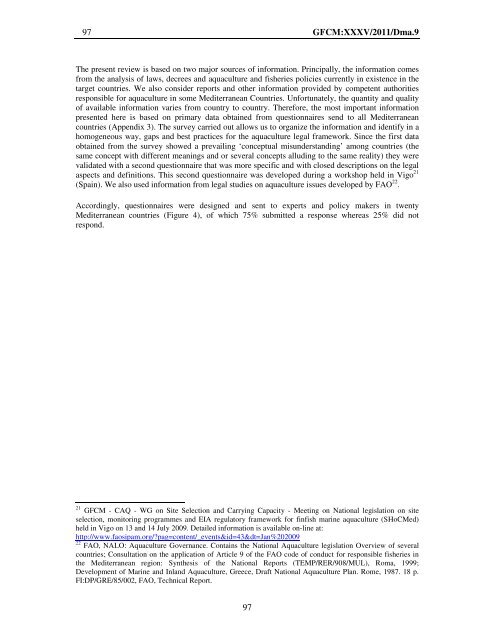Site selection and carrying capacity in Mediterranean ... - FAO Sipam
Site selection and carrying capacity in Mediterranean ... - FAO Sipam
Site selection and carrying capacity in Mediterranean ... - FAO Sipam
Create successful ePaper yourself
Turn your PDF publications into a flip-book with our unique Google optimized e-Paper software.
97 GFCM:XXXV/2011/Dma.9<br />
The present review is based on two major sources of <strong>in</strong>formation. Pr<strong>in</strong>cipally, the <strong>in</strong>formation comes<br />
from the analysis of laws, decrees <strong>and</strong> aquaculture <strong>and</strong> fisheries policies currently <strong>in</strong> existence <strong>in</strong> the<br />
target countries. We also consider reports <strong>and</strong> other <strong>in</strong>formation provided by competent authorities<br />
responsible for aquaculture <strong>in</strong> some <strong>Mediterranean</strong> Countries. Unfortunately, the quantity <strong>and</strong> quality<br />
of available <strong>in</strong>formation varies from country to country. Therefore, the most important <strong>in</strong>formation<br />
presented here is based on primary data obta<strong>in</strong>ed from questionnaires send to all <strong>Mediterranean</strong><br />
countries (Appendix 3). The survey carried out allows us to organize the <strong>in</strong>formation <strong>and</strong> identify <strong>in</strong> a<br />
homogeneous way, gaps <strong>and</strong> best practices for the aquaculture legal framework. S<strong>in</strong>ce the first data<br />
obta<strong>in</strong>ed from the survey showed a prevail<strong>in</strong>g ‘conceptual misunderst<strong>and</strong><strong>in</strong>g’ among countries (the<br />
same concept with different mean<strong>in</strong>gs <strong>and</strong> or several concepts allud<strong>in</strong>g to the same reality) they were<br />
validated with a second questionnaire that was more specific <strong>and</strong> with closed descriptions on the legal<br />
aspects <strong>and</strong> def<strong>in</strong>itions. This second questionnaire was developed dur<strong>in</strong>g a workshop held <strong>in</strong> Vigo 21<br />
(Spa<strong>in</strong>). We also used <strong>in</strong>formation from legal studies on aquaculture issues developed by <strong>FAO</strong> 22 .<br />
Accord<strong>in</strong>gly, questionnaires were designed <strong>and</strong> sent to experts <strong>and</strong> policy makers <strong>in</strong> twenty<br />
<strong>Mediterranean</strong> countries (Figure 4), of which 75% submitted a response whereas 25% did not<br />
respond.<br />
21 GFCM - CAQ - WG on <strong>Site</strong> Selection <strong>and</strong> Carry<strong>in</strong>g Capacity - Meet<strong>in</strong>g on National legislation on site<br />
<strong>selection</strong>, monitor<strong>in</strong>g programmes <strong>and</strong> EIA regulatory framework for f<strong>in</strong>fish mar<strong>in</strong>e aquaculture (SHoCMed)<br />
held <strong>in</strong> Vigo on 13 <strong>and</strong> 14 July 2009. Detailed <strong>in</strong>formation is available on-l<strong>in</strong>e at:<br />
http://www.faosipam.org/?pag=content/_events&id=43&dt=Jan%202009<br />
22 <strong>FAO</strong>, NALO: Aquaculture Governance. Conta<strong>in</strong>s the National Aquaculture legislation Overview of several<br />
countries; Consultation on the application of Article 9 of the <strong>FAO</strong> code of conduct for responsible fisheries <strong>in</strong><br />
the <strong>Mediterranean</strong> region: Synthesis of the National Reports (TEMP/RER/908/MUL), Roma, 1999;<br />
Development of Mar<strong>in</strong>e <strong>and</strong> Inl<strong>and</strong> Aquaculture, Greece, Draft National Aquaculture Plan. Rome, 1987. 18 p.<br />
FI:DP/GRE/85/002, <strong>FAO</strong>, Technical Report.<br />
97
















